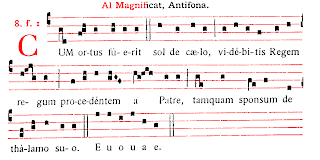Face of Christ
from St. John’s Anglican Church, Ashfield, Australia (Wikimedia Commons)
An ancient Gregorian chant compares sunrise on Christmas morning to Christ coming out of his bedroom to join in mystical marriage with people who love him:
“When the sun shall have risen in the heavens, ye shall see the King of Kings coming from the Father, as a Bridegroom from his bride-chamber.” *
The erotic, even homoerotic, words translate a Latin liturgical antiphon for First Vespers on Christmas Day: “Cum ortus fuerit sol de Caelo, videbitis Regem regum procedentem a Patre, tanquam sponsum de thalamo suo.”
“To start the Christmas season, the Church uses an image of the Son emerging from the marital bliss of the Godhead's bridal suite. It has God himself in a same-sex marriage! And in case we missed the antiphon, it is repeated in the liturgy the following day,” says Kevin Elphick, a Franciscan scholar and a supervisor on a suicide prevention hotline in New York.
The text is apparently a Christian adaptation of Psalm 19: 4-5: “In the heavens God has pitched a tent for the sun. It is like a bridegroom coming out of his chamber, like a champion rejoicing to run his course.”
Elphick points out that nuptial intimacy among the Persons of the Trinity might seem surprising, but is part of a long tradition about the Trinity. Sixteenth-century Spanish mystic John of the Cross expressed it well in his “Romance sobre el Evangelio,” where he describes the Trinity as Lover, Beloved and Love. Medieval Belgian theologian William of Saint-Thierry calls the Holy Spirit the “Kiss” and “Embrace” of the first two Persons of the Trinity. Medieval Dutch mystic Hadewijch of Brabant names the mutual unity of all three Persons as their common “Kiss” in her writings.
Episcopalian priest Robert Farrar Capon described the Holy Spirit as the magical marital “Bed” of the Trinity his book “Health, Money, and Love.” He writes: “Once before all time, there was a Lover, a Beloved, and a magical Bed in which they played out the unity of their love. The joy of the two of them in that Bed was complete: there was nothing besides their love, and there was nothing they needed to make their happiness more perfect.” His use of the word “Bed” parallels the “bridal chamber” in the ancient Christmas antiphon.
The Latin uses the word “thalamo” for the bridal chamber. Elphick reports that the Latin Vulgate Bible uses the same word in the marital chamber context in Psalm 18:6 and Joel 2:16. The word is related to the bedroom in both Latin and Greek (thálamos).
The chant is especially suitable for sunrise on Christmas morning because it draws on another ancient tradition connecting Christ with the sun. The lines in Psalm 19 about the sun being like a bridegroom were popular with early Christians. They associated it with the early Christian custom of praying while facing east, the direction of Christ’s ascension and second coming. The star that led the Magi to the baby Jesus also rose in the east.
The text and plainsong melody of the chant are anonymous, but it was put into more elaborate musical settings by Renaissance composers whose names are known: Flemish composer Nicholas Gombert (c1490 - 1561) and English composer Thomas Tallis (c1505 - 1585). Gombert’s version is performed by the Tallis Singers on the album “Nicolas Gombert: Magnificats 1-4.” The Tallis version is on the album “Christmas Vespers at Westminster Cathedral.” (However the English text introducing the Westminster album conveniently deletes the erotic part of “Cum ortis”!)
Gombert, who was master of the children’s choir at the imperial chapel, was convicted of sexual contact with a boy in his care and was sentenced to hard labor in the galleys in 1540. It is said that during his years of punishment he wrote eight Magnificat settings, including the “Cum ortus fuerit” chant, as an offering to Holy Roman Emperor Charles V. The emperor was so moved by Gombert’s music that he pardoned the composer and granted him and early release.
___
* The chant is translated into contemporary English in “An Introduction to Gregorian Chant, Volume 1” by Richard L. Crocker:
When the sun has risen in the sky,
you will see the king of kings proceeding from the Father,
like a bridegroom out of his chamber.
____
This post is part of the Queer Christ series by Kittredge Cherry at the Jesus in Love Blog. The series gathers together visions of the queer Christ as presented by artists, writers, theologians and others.
Copyright © Kittredge Cherry. All rights reserved.
http://www.jesusinlove.blogspot.com/
Jesus in Love Blog on LGBT spirituality and the arts


No comments:
Post a Comment